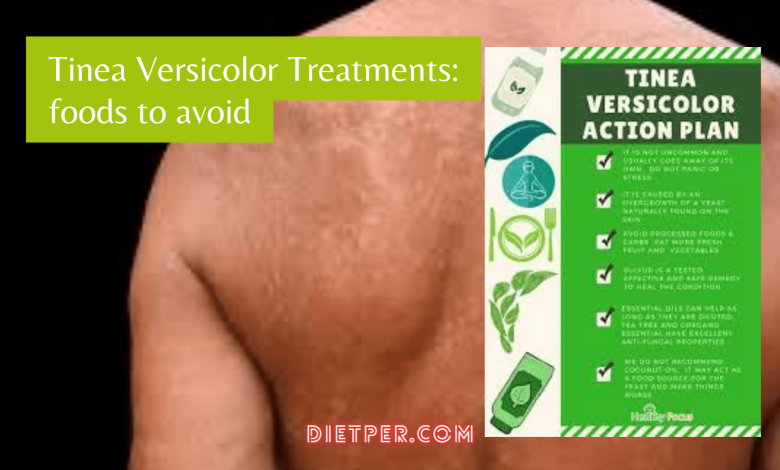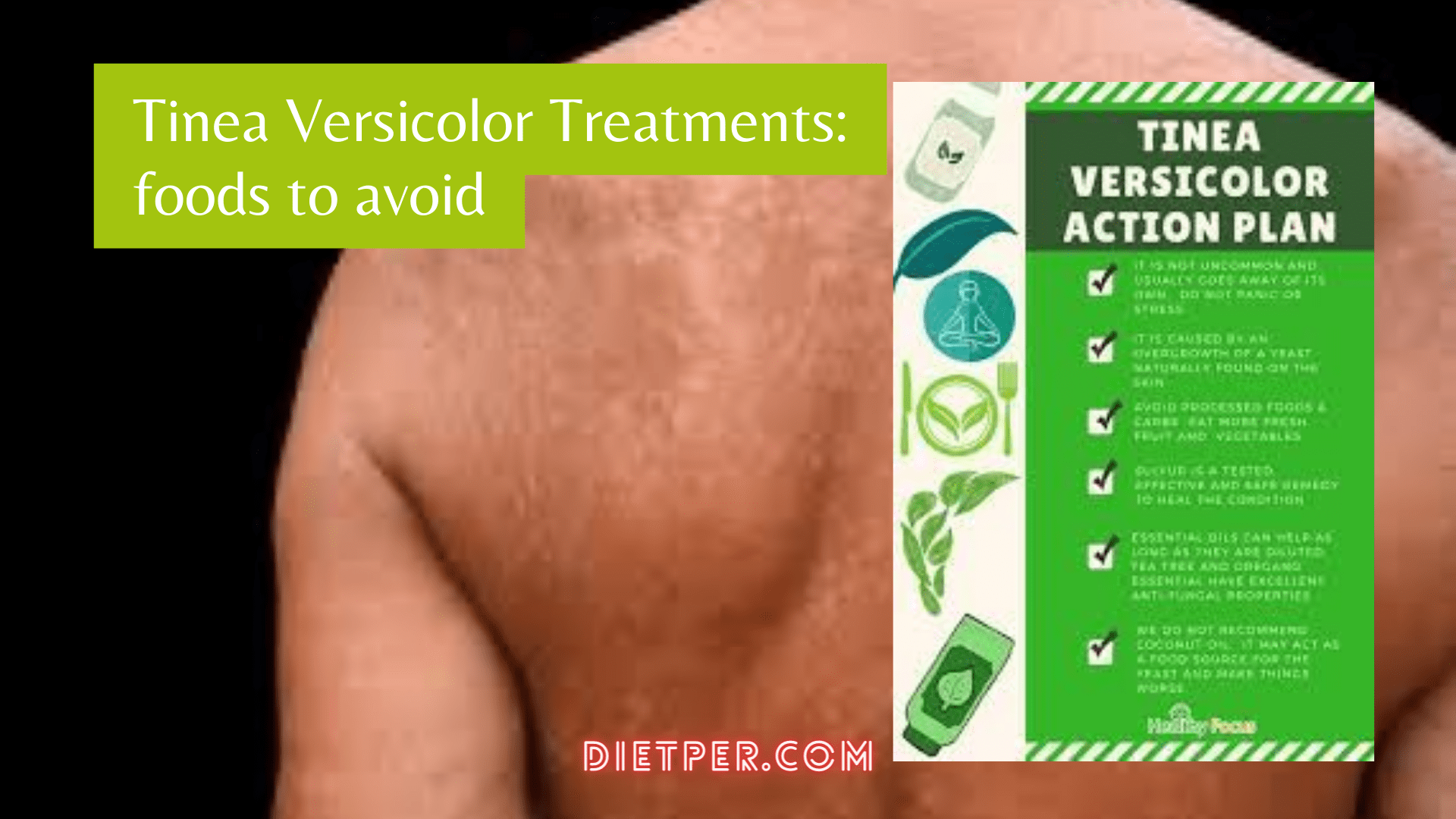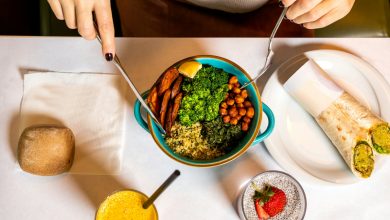Tinea Versicolor Treatments: foods to avoid
Tinea Versicolor Diet and Tinea Versicolor Treatments

Tinea versicolor is a fungal skin infection most commonly seen in people between the ages of 20 and 40. The fungus thrives in warm, moist conditions and can be spread through contact with items contaminated with the fungus, such as clothing, furniture, or other objects. While the fungus is not deadly, it can cause irritation and a skin condition called tinea versicolor. This post will share foods to avoid if you suffer from tinea versicolor. By avoiding these foods, you will help to prevent the fungus from thriving and spreading.
What is tinea versicolor?
Tinea versicolor is a condition of the skin caused by a fungus. The fungus is found in the soil, on plants, or animals. It can live on the skin in a state called the asymptomatic carriage. The fungus can cause a skin infection that is commonly called tinea versicolor/pityriasis versicolor.
There are many foods that you may be eating that could be contributing to your skin infection. Here are some of the major typical foods to avoid if you have tinea versicolor:
- 1. Mushrooms
- 2. Fried foods
- 3. Hot foods
- 4. Dairy products
- 5. Garlic
- 6. Tomatoes
- 7. Canned fruits and vegetables
- 8. Wheat
- 9. Corn
- 10. Sugars
- Tinea Versicolor Diet : The Guide for Clearer Skin
- Pho Dac Diet: The Latest Weight Loss Trend
- Pityriasis Versicolor: Causes, Symptoms, and Treatment Options
Foods to avoid when treating tinea versicolor
Many foods can aggravate tinea versicolor and make the skin lesions worse. The foods you should avoid the most when treating this condition are high sugar, dairy, and citrus.
Sugar can worsen the condition by promoting yeast overgrowth. Dairy products can lead to increased inflammation and the development of pus, and citrus fruits contain high levels of vitamin C, which can further irritate the skin.
If treating tinea versicolor, it is important to adhere to a strict diet that excludes these high-risk items. If you find yourself eating one of the high-risk foods, wait until the skin lesions have cleared before consuming the food again. If the lesions are still present, you should not consume the food.
How to avoid food allergies and sensitivities when treating tinea versicolor
There are periodic foods to avoid when treating tinea versicolor, as they may cause a worsening of the condition. Some of the most common offenders are:
- Wheat products: These include bread, pasta, pastry, cereal, and anything that contains wheat.
- Dairy products: This includes milk, cheese, ice cream, and yoghurt.
- Eggs: These are a common allergen and should be avoided if you’re trying to treat tinea versicolor.
- Nuts and seeds: These contain several allergens, including nuts, seeds, and legumes.
It’s important to discuss any food allergies or sensitivities with your doctor before starting any treatment, as they may need to be modified to avoid any potential triggers.
Foods to eat when treating tinea versicolor
There are many foods to avoid when treating tinea versicolor. Some of the most common are listed below. Please consult with your doctor before altering your diet to treat tinea versicolor.
- To prevent fungal overgrowth, avoid alcohol, caffeine, hot foods, spicy foods, and dairy products.
- To soothe the skin, apply a topical cream or ointment containing zinc, selenium, or vitamin A.
- To speed healing, drink plenty of water, avoid rigorous exercise, and keep the skin dry.
Tips for successful tinea versicolor treatment
You should avoid many foods when treating tinea versicolor, but here are a few of the most common offenders.
- 1. Raw and undercooked meat
- 2. Raw vegetables
- 3. Alcohol
- 4. Caffeine
- 5. Hot, spicy, and acidic foods
- 6. Fruit juices
- 7. Unpasteurized milk and milk products
- 8. Unwashed fruits and vegetables
- 9. Synthetic fragrances
- 10. Sun exposure
Although it’s a good idea to avoid foods most likely to cause your tinea versicolor to flare up, it’s also important to remember that many foods are healthy and can be enjoyed during treatment.
The most suitable foods to eat while trying to treat tinea versicolor include yoghurt, eggs, chicken, salmon, asparagus, spinach, and carrots. It’s also a good idea to avoid garlic, onion, and other strong spices.
It’s also important to remember that many topical treatments can use to treat tinea versicolor. These topical treatments can be applied directly to the skin or in conjunction with other topical treatments.
If you are struggling with tinea versicolor and are looking for a way to treat it successfully, it’s important to talk to your doctor about your options. Many treatments are available, and your doctor can recommend the best one.
Tinea versicolor home remedies
There are occasional foods to avoid when you have tinea versicolor. Some of these foods are:
- Raw fruits and vegetables: These can cause the fungus to grow.
- Brewed coffee: This is a common trigger for fungus.
- Alcohol: This can also trigger the fungus.
- Hot tea: This is another common trigger.
- Creams and lotions: These can help the fungus spread.
If you have home remedies for tinea versicolor and are unsure what food might have caused it, it is best to consult your doctor.
When to consult a doctor
Tinea versicolor is a fungal infection that most often affects the skin of the trunk, arms, and legs. While it is not serious in most cases, it can lead to long-term skin damage if not treated.
Here are four foods to avoid if you have tinea versicolor:
- 1. Alcohol
- 2. Caffeine
- 3. Chocolate
- 4. Hot spices
If you do not have tinea versicolor and are experiencing any symptoms, consult a doctor. Many treatments are available, and early diagnosis is key to successful treatment.
Possible side effects of treatments
There are many food items to avoid while undergoing tinea versicolor treatments. Many people mistakenly believe these foods will not aggravate their skin and help speed up healing. However, this is not always the case.
Some common food items to avoid while undergoing tinea versicolor treatments are as follows:
- 1. Dairy products – dairy products, specifically cheese, can aggravate the skin due to their high level of casein. This is because casein is a protein that can stimulate the skin’s immune response.
- 2. Caffeine – caffeine can also aggravate the skin due to its stimulatory properties.
- 3. Alcohol – alcohol can dehydrate the skin, which can make the skin better susceptible to inflammation and infection.
- 4. Sugary foods – especially those with high fructose- can also aggravate the skin.
- 5. Hot foods can also aggravate the skin due to their inflammatory properties.
- 6. Garlic – garlic is a powerful anti-microbial agent and can irritate the skin.
- 7. Fruit – some fruit, such as grapes, can contain natural toxins that aggravate the skin.
- 8. Wheat – wheat is a common allergen, and while it is not the only allergen that can aggravate the skin, it is one of the most common.
Avoiding these foods can help reduce the risk of side effects and speed up the healing process.
Final Thought
We hope you appreciated our blog post about tinea versicolor treatments. We know that many people are curious about what foods to avoid when trying to treat tinea versicolor. This post outlined the top 6 foods to avoid while treating tinea versicolor. We also included a video that goes into more detail about these foods and how to avoid them. We hope that this information will help you treat tinea versicolor successfully. Thanks for reading!
People Also Ask
What foods make tinea versicolor worse?
Tinea versicolor is a fungal infection commonly seen on the skin caused by several factors, including topical steroids, hair dye, and the wrong type of soap. The condition’s symptoms are typically red, scaly patches on the skin that can make it itchy. Different factors can trigger skin infections like this — and often, you’ll find that foods or beverages are to blame. To help prevent the development of this condition, it’s important to know what foods make tinea versicolor worse.
What meals should be avoided with fungal infections?
In a healthy diet, certain foods should avoid with fungal infections. If a particular food is in the diet and the patient is experiencing any fungal infection, the patient should avoid it. To help patients with a fungal infection, a dietitian can consult. The diet should restrict to foods that are high in nutrients, low in starches, and low in sugar.
Does sugar cause tinea versicolor?
Tinea versicolor, or pityriasis Versicolor, is a skin condition that causes small, dark, flat-topped bumps to form on the skin. The condition can affect adults and children, but it is more common in adults. It is caused by various fungi that live in the skin’s hair follicles. This fungi can be found on most body parts but is most common on the back and chest. The fungus thrives in warm, moist areas and on the skin’s surface. If the fungus is not removed, it can grow out of control and cause discomfort and other problems.
What is the finest soap for tinea versicolor?
No soap is just for tinea versicolor. However, if you’re treating a case of tinea versicolor, you will want to do two things: wash your skin with soap and dry it entirely with a towel or a hair dryer.
What is tinea flava treatment?
Tinea flava, or pityriasis versicolor, is a common skin condition affecting many people worldwide. Characterized by discoloured patches on the skin, this fungal infection can be uncomfortable and embarrassing. The good news is that several effective treatment options are available to help alleviate the symptoms and restore the skin’s natural appearance.
How to treat tinea versicolor at home?
Tinea versicolor, a common skin condition caused by a fungal infection, can be quite bothersome. The good news is that you can effectively treat it at home. Here are some tried and tested methods to help you combat tinea versicolor in the comfort of your home.
1. Use antifungal creams
2. Apply natural remedies
3. Opt for medicated shampoos
4. Maintain good hygiene practices
5. Avoid excessive sun exposure
6. Consider dietary changes

Tinea versicolor Diet Plan Chart




